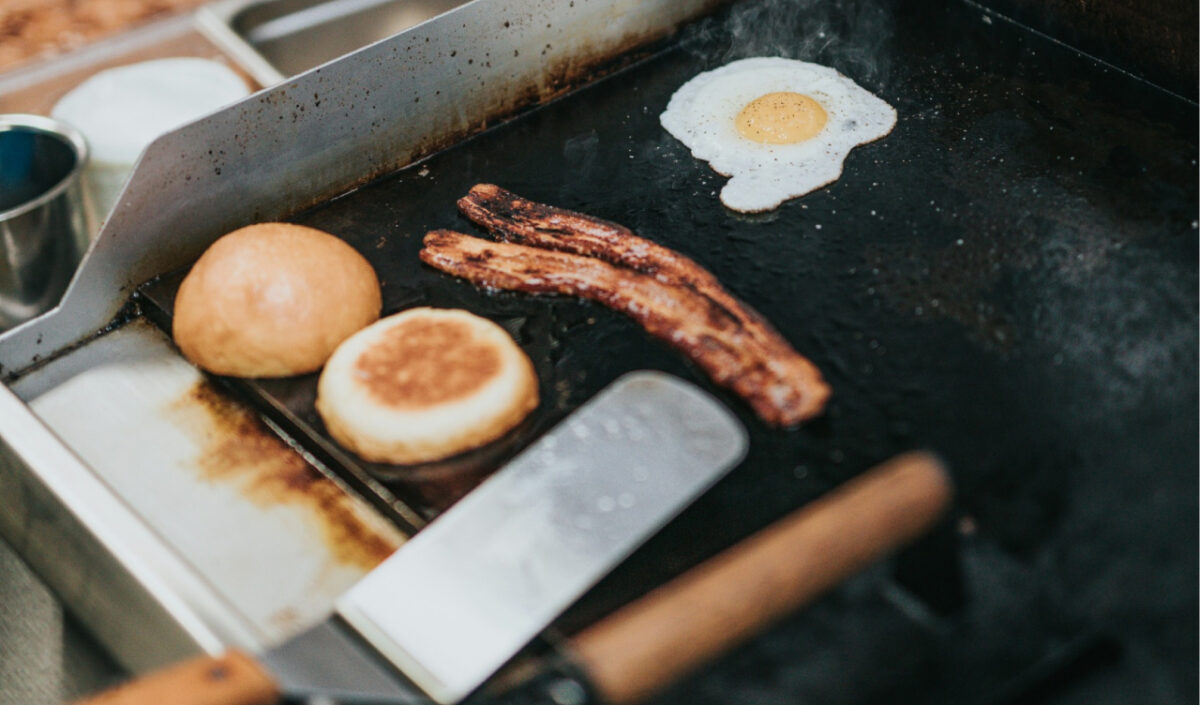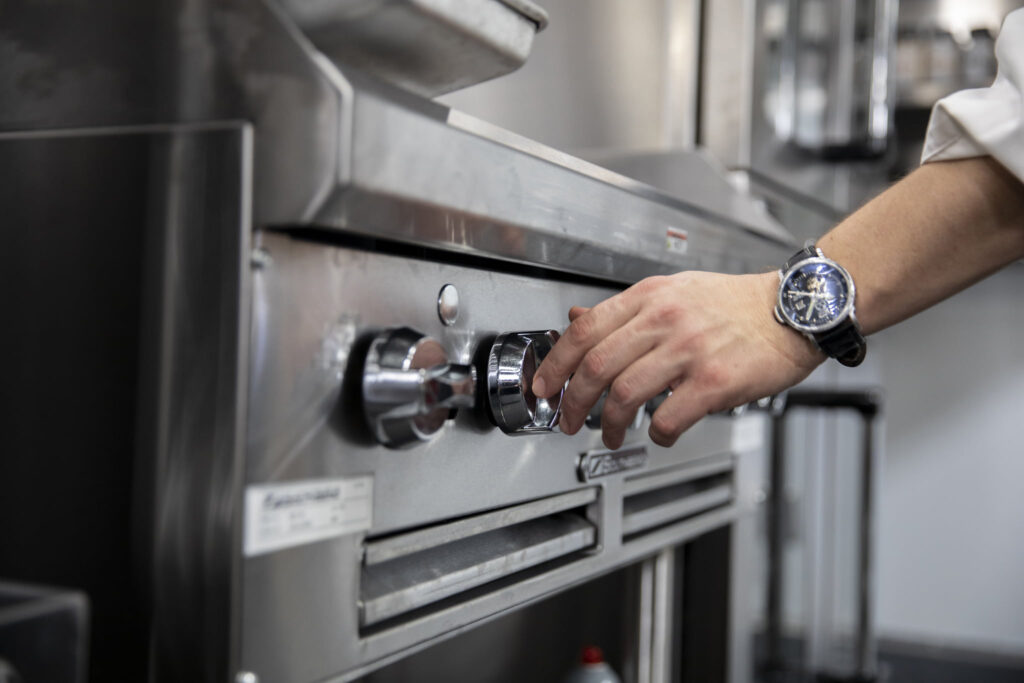Solving the riddle of how to clean your flat top grill or griddle

The sizzle of a griddle is behind so many of our favorite foods in restaurants across the country, from breakfast to burgers to fajitas and more. But you certainly don’t want the food coming off your griddle to have a funky taste, and you definitely don’t want your griddle to become unusable before its time.
So learning how to clean a commercial flat top grill is of the essence! Let’s get into it.
Understanding the commercial flat top grill
A commercial flat top grill or griddle has a number of elements, from switches and knobs to a pilot light, but the most important thing when it comes to cleaning is the cooking surface. Commercial griddles have a few different types of cooking surfaces, which will make a significant difference in how you approach cleaning them.
Steel plate: A steel plate is probably the most common surface you’ll see on a kitchen griddle/flat top. Steel is cost-effective and long-lasting, but it radiates heat and requires more elbow grease to clean (although you will have a wider range of cleaning products available to you). It also tends to look a little beat up after use, even when it is clean, unless you deep clean it.
Chrome plate: A chrome plate has a very clean look throughout its life, unlike a steel plate, and is easier to clean. These plates tend to be a bit more expensive.
Composite plate: This is a relatively new technology applied to griddles. A composite plate offers superior heat transfer (up to 5 times ordinary plates!) and cools quickly. These plates are easy to clean and usually are less expensive than chrome plates, if pricier than steel.
Cast iron plate: This material can last a lifetime if you take care of it as you would any other type of cast iron cookware, but it doesn’t really come in commercially appropriate sizes.
No matter which material your plate is made of, you have to clean it frequently, as in every time you use it. If a griddle or a flat top isn’t cleaned regularly, it can easily chip or rust. Buildup of grease and burned food is bad for your customers’ experience and health, and a potential fire hazard. A clean griddle also heats much more consistently and effectively — which lowers your energy costs and transfers directly to your customers’ enjoyment of food (and not to mention helps avoid food poisoning!)
Best practices for daily cleaning of your commercial flat top
Ideally, you are cleaning your griddle after every meal or at the very least a meal service. It only takes 5 to 10 minutes! The bare minimum for cleaning after heavy use is daily. Again, the more you can avoid buildup on the griddle, the better food will taste and the longer your griddle will last.
1. The number one thing you have to do no matter what type of griddle surface material you have is let it cool. Never use ice to cool down the griddle — just let it cool.
2. Once the griddle has cooled to 300 °F to 350 °F, scrape off debris hanging out on the surface (what you should use to scrape depends on your surface material — see below). You can scrape the debris into the waste drawer of the griddle.
3. Use room temperature water, a mild, surface-safe detergent and a brush (see below for which type of brush to use by surface) to make sure all the debris is off. (You can skip the detergent if you have a chrome plate).
4. Make sure all the detergent is off by flushing or squeegeeing the plate with water until the griddle is fully clean. If cleaning chrome, apply a food safe polish now, then use a damp cloth to remove the polish.
5. Use cooking oil to reseason the grill/griddle. This will also help prevent rust.
Tools to keep your commercial flat top in top shape

The basic procedure for any kind of griddle is the same, but the tools you will use to go about it differ by surface, as do the flat top grill cleaner products available to you.
Steel plate:
For a steel plate, you can use a griddle or grill scraper and a griddle brick or pumice stone. You can use normal dish soap. You can also use a polish appropriate for steel plates.
Chrome plate:
Although it’s easier to clean than other types of plate, you have to be careful cleaning a chrome (or chromium plate). Use food-safe polish, a Palmetto brush and a special razor blade scraper that’s designed for the purpose of a chromium plate as your tools. Do NOT use anything abrasive, like what you would use for a steel plate (pumice, griddle stone, steel wool, etc.). Do not use any sharp instrument or metal spatula edge to remove food — only use the tool designed to remove debris from chromium. And do not use typical liquid grill cleaners or flat top grill cleaner products.
Composite plate:
Use a standard scraper, mild detergents and non-abrasive cleaning products to clean this. It should be relatively easy — a scrubby pad that is non-abrasive should do the trick.
Note: If you have a cast iron griddle, clean it like you would a skillet or other cast iron equipment. As always, this piece of standard advice holds: follow the manufacturer instructions for what you have (or call Eleven36 for help if you don’t know!)
Always make sure to clean and sanitize your knobs and your debris drawer in a griddle as well.
When to deep clean your griddle

Getting rid of debris and giving your griddle a thorough wipe down as frequently as possible will help keep it lasting and performing for a long time. But you’ll sometimes find as you’re cooking that a griddle, specifically a steel griddle, loses its coating of seasoning, particularly if you are using heavy sauces, and that you want to fully deep clean it to reseason. If you find you need to deep clean your griddle, you can use chemicals or fresh squeezed lemon on the surface, chased by room temperature water while the griddle is on. You can also use white vinegar. Make sure your entire surface is covered. The acidity will help pull the seasoning off. With a special sharp scraper, you can scrape up the seasoning. (Note: do not use this on a chrome plate, for which this whole process is unnecessary anyway.) For stubborn areas, you rub a lemon directly on the griddle and use a cleaning pad to rub the lemon juice in more deeply. If you follow this process thoroughly, your steel plate will look brand new. You can get it even cleaner by using a hand sander on top of that. (Note: These instructions are specific for steel plates!)
For a composite or chromium plate, getting through a deep clean this thorough should not be necessary. A little detergent will go a long way. And always make sure that your surface will not be corroded by vinegar or lemon juice.
Getting the right flat top grill cleaner products
In cleaning any appliance, this cannot be emphasized enough: Make sure you buy the right products for the material. Regardless of surface, you do not want scratches to allow for debris build up — so make sure your brushes and scrapers are appropriate for the material. Do not use anything sharp on chrome/chromium plates — use a Palmetto brush, Palmyra brush, bladed scraper, soft sponges and microfiber cloths. You will also need to use special cleaners for chrome/chromium, like food-safe polish. Steel plates can handle scrapers, bricks, and even putty knives, but always go with, not against the grain, to remove scratches. Always check to make sure your product fits its application when you clean anything in the kitchen.
Extending the life of your flat top grill
By cleaning your grill appropriately, carefully and frequently, you will find that it cooks consistently and deliciously for a very long time. Cleaning back and side splashes as you go will help make cleaning easier throughout the day, too. Seasoning the grill right will also help prevent build up of debris.
Why proper maintenance matters
Not cleaning a grill or griddle correctly can slowly (or quickly!) make your investment in a quality griddle less worthwhile. Infrequent cleaning will make the eventual cleaning you do more difficult, as the debris, oil and fat will cake on. Having to use harsh chemicals can be less appealing than natural solutions given how much water will need to be used to rinse them off. And using the wrong chemicals will do damage to your surface, which is the star of the show. Cleaning frequently, and giving the griddle a little extra love each week with a deeper clean if not necessarily a fully deep, scrape-off-all-seasoning-and-reseason-clean, will go a long way. Following our steps for daily cleaning will help take the riddle out of how to clean griddle units!
And one last thing: Do be careful when cleaning your griddle — you must always clean it while hot, which means gloves are probably a good idea. You may also want to wear goggles if you are worried about grease, oil and water flying as you clean. But once you get the hang of cleaning a griddle, it’s easy, and worth it — and you and your customers will find yourselves satisfied every time you hear “Order up!”
